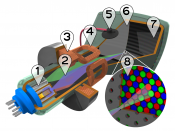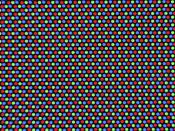This paper is concentrated on influences of visual display terminals (VDTs) on its user. In the previous research (Reznik, 2001, Humanities 2001) I have found that VDTs are indeed causes different eye problems. This paper will accomplish further research and find ways to eliminate vision problems.
In an article by David Thomson "Eye problems and Visual Display Units - facts and the fallacies", the author discusses only Cathode Ray Tube (CRT) monitors, which were the most used monitors before Liquid Crystal Displays (LCDs) came in to use. A CRT is a an evacuated glass tube with a phosphorcoated screen at one end and a flament and deflection coils at the other. Electrons emitted by the filament and accelerated, focused and deflected by the action of the deflection coils. The electron beam strikes the screen at the other end of the tube and at the point of impact phosphor emits light (Thomson, 1998).
Thus digital images are created. LCDs' advantages are that it is flicker-free, meaning it does not need to refresh its display, because it is using liquid crystals which updates the data shown on the monitor automatically. Also LCDs have adjustable luminanace that does not affect the size of the pixel (smallest displayable square unit). CRTs refresh rate varies from display to display, and by adjusting the luminance you have to change the size of the pixel, and that of course leads to not precisable appearance of data on the VDT.
In the article by M Menozzi "CRT versus LCD: effects of refresh rate, display technology and background luminance in visual performance" two experiments were carried out to find difference in influence on one's vision by a CRT and an LCD visual display terminals.
In the first experiment - tested subject's performance while performing a visual...


